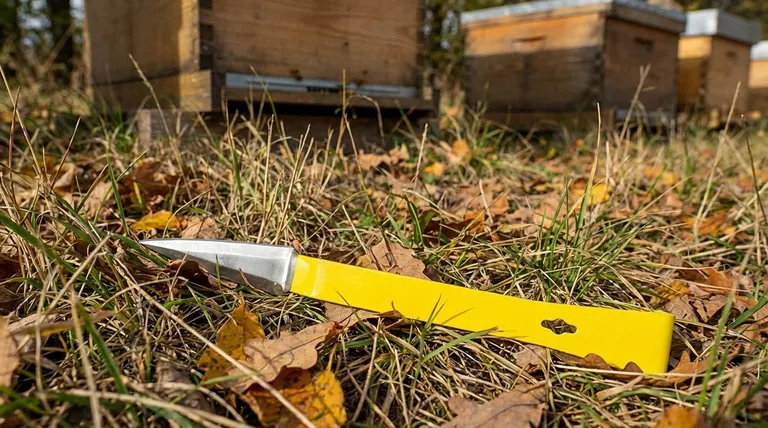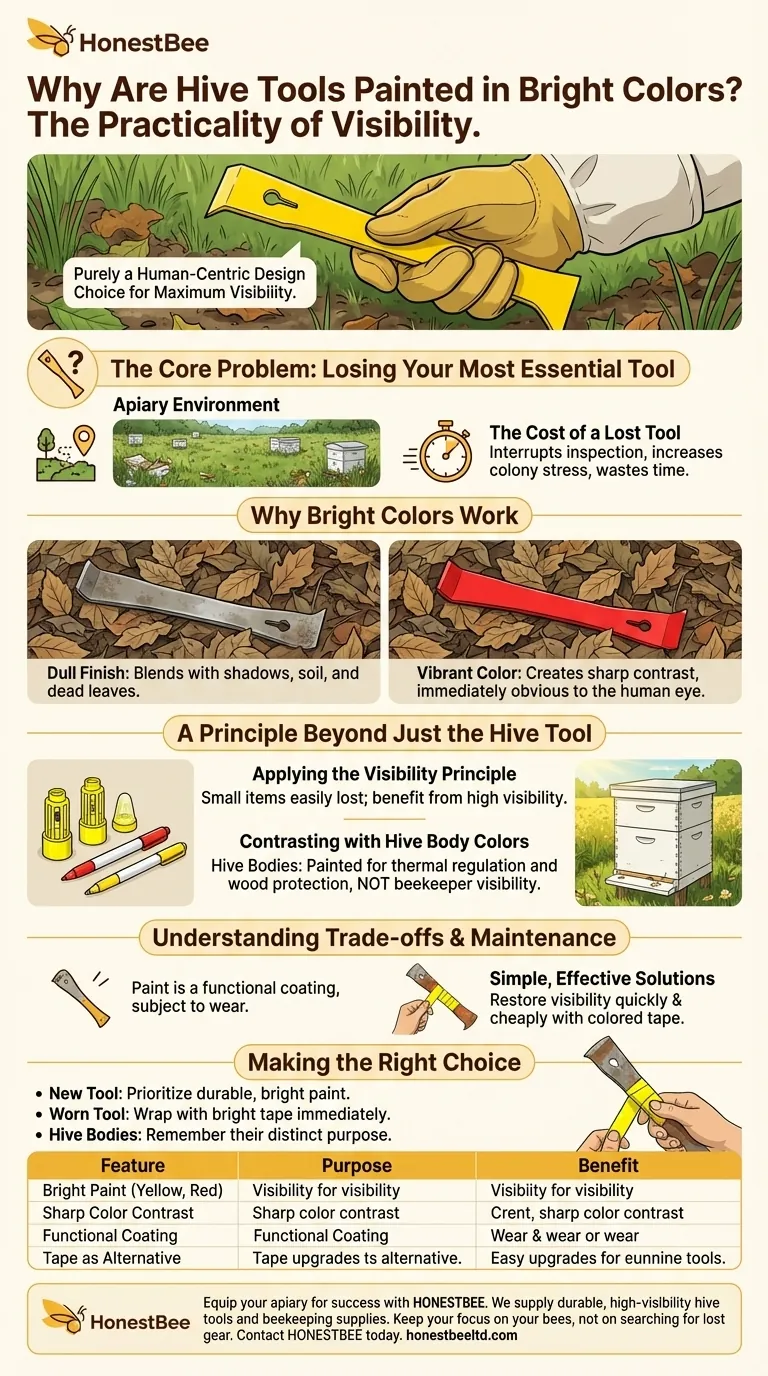In beekeeping, a simple detail can make a significant difference. Hive tools are painted in bright, conspicuous colors for a single, practical reason: to ensure they are easy to find. When you're focused on an inspection and set your tool down, a bright yellow or red handle stands out clearly against the grass, leaves, and dirt of an apiary, preventing a frustrating search or the loss of an essential piece of equipment.
The bright color on a hive tool has no function for the bees or the hive itself. It is purely a human-centric design choice to maximize visibility and prevent the beekeeper from losing their most crucial tool during hive work.

The Core Problem: Losing Your Most Essential Tool
A hive tool is the beekeeper's primary instrument for interacting with a colony. Losing it, even temporarily, can turn a smooth inspection into a stressful situation for both the beekeeper and the bees.
The Apiary Environment
Apiaries are rarely pristine environments. They are typically set in grassy fields, wooded areas, or gardens where a dropped tool can easily become camouflaged by natural ground cover.
The Cost of a Lost Tool
Misplacing your hive tool mid-inspection forces you to stop what you're doing. This interruption can leave a hive open for longer than necessary, increasing the defensive response from the colony and disrupting your workflow.
Why Bright Colors Work
A standard, unpainted metallic tool has a dull gray or silver finish that blends in remarkably well with shadows, soil, and dead leaves. In contrast, unnatural colors like vibrant yellow, red, or blue create a sharp visual contrast, making the tool immediately obvious to the human eye.
A Principle Beyond Just the Hive Tool
This concept of high-visibility design extends to other aspects of beekeeping equipment, but it's important not to confuse it with the principles behind painting the hive itself.
Applying the Visibility Principle
Other small, easily misplaced items benefit from the same logic. Queen cages, marking pens, and queen clips are often produced in bright colors to ensure they aren't accidentally lost inside a bustling hive or dropped on the ground.
Contrasting with Hive Body Colors
While tools are colored for the beekeeper, hive bodies are painted for the bees and for durability. A light-colored, reflective paint (like white) helps keep the hive cooler in the summer sun and protects the wood from weather damage. Different colors or patterns on adjacent hives can also help foraging bees find their correct home, reducing "drifting" between colonies.
Understanding the Trade-offs and Maintenance
The paint on a hive tool is not permanent. It is a functional coating that is subjected to constant scraping, prying, and the sticky, abrasive nature of propolis.
When the Paint Wears Off
It is completely normal for the paint to chip and wear away with regular use. The ends of the tool, which do the most work, will often lose their paint first.
Simple, Effective Solutions
When the color fades, you don't need to replace the tool. A common practice is to wrap the handle with brightly colored tape, such as electrical tape or a vibrant duct tape. This restores its high visibility quickly and cheaply.
The Downside of No Color
Working with an unpainted or worn tool significantly increases your risk of losing it. The few minutes it takes to add tape to a handle is a worthwhile investment compared to the cost and frustration of replacing a lost tool.
Making the Right Choice for Your Gear
Applying this simple principle of visibility will make your beekeeping experience smoother and more efficient.
- If you are purchasing a new hive tool: Prioritize one with a durable, brightly colored paint job to save yourself future frustration.
- If you have an unpainted or worn tool: Immediately wrap the handle with bright red, yellow, or blue tape as a simple and effective upgrade.
- When considering your hive bodies: Remember their color serves a different purpose—thermal regulation for the colony and protection for the wood.
Ultimately, a visible tool is a reliable tool, ensuring your focus remains on the health and productivity of your bees.
Summary Table:
| Feature | Purpose | Benefit |
|---|---|---|
| Bright Paint (Yellow, Red) | High visibility for the beekeeper | Easy to find if dropped in grass or leaves |
| Sharp Color Contrast | Stands out against natural backgrounds | Saves time and reduces stress during inspections |
| Functional Coating | Designed to wear with use | A simple, cost-effective solution |
| Tape as Alternative | Restores visibility on worn tools | A cheap and easy upgrade for any tool |
Equip your apiary for success with HONESTBEE.
A lost hive tool disrupts your workflow and stresses your colony. At HONESTBEE, we understand that reliable, high-visibility equipment is non-negotiable for commercial beekeepers and distributors. We supply durable, brightly colored hive tools and a full range of beekeeping supplies designed for efficiency and durability in demanding conditions.
Let us help you keep your focus on your bees, not on searching for lost gear.
Contact HONESTBEE today to discuss your wholesale supply needs and discover how our equipment can enhance your operation's productivity.
Visual Guide

Related Products
- HONESTBEE Professional Long Handled Hive Tool with Precision Cutting Blade
- HONESTBEE Advanced Ergonomic Stainless Steel Hive Tool for Beekeeping
- Professional Drop-Style Hive Handles for Beekeeping
- HONESTBEE 15-in-1 Beekeeper Multi-Tool with Hammer and Pliers for Beekeeping
- Professional Dual-End Stainless Steel Hive Tool for Beekeeping
People Also Ask
- Why do hive tools have a hole? Unlock the Secret to Efficient Beekeeping
- What is the hive tool used for? The Essential Multi-Tool for Every Beekeeper
- What are the features of a regular hive tool? The Essential Multi-Tool for Every Beekeeper
- How can a hive tool be used to remove propolis and burr comb? Master Hive Maintenance for a Healthy Colony
- What are some common uses of a hive tool? Essential Multi-Purpose Tool for Every Beekeeper



















